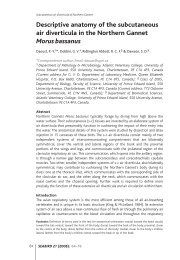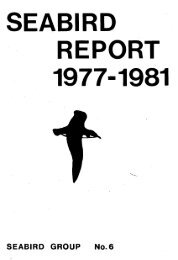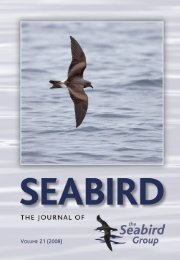You also want an ePaper? Increase the reach of your titles
YUMPU automatically turns print PDFs into web optimized ePapers that Google loves.
190 W.R.P. BOURNE & K.E.L. SIMMONS Atlantic <strong>Seabird</strong>s 3(4)<br />
7.9S<br />
8.0S<br />
old guano deps.<br />
Ascension<br />
Wideawake Fairs<br />
14.4W 14.3W<br />
<strong>The</strong> possibility that seabirds were once more numerous is confirmed by<br />
a report by Van Linschoten in 1589. When they called at Ascension "birds of<br />
the bignesse of young geese... came by thousands flying about our ships, crying<br />
and making great noyse, and ran up and down in the ship, some leaping and<br />
sitting on our shoulders and armes, not once fearing us, so that we took many of<br />
them and rung their neckes, but they are not good to eate, because they taste<br />
morish (fishy)" (Tiede 1885), in a way now unknown anywhere. <strong>The</strong> large<br />
seabird seen most often by the RNBWS on ships in the tropics is the Red-footed<br />
Booby, which normally nests on trees and is now rare at Ascension. Its fossil<br />
remains are common there, however, and the lava-flows are stained with old<br />
guano in patterns suggesting it nested on them instead.<br />
N<br />
Boatswainbird Islet<br />
Figure 2. Ascension Island, location of greatest old guano deposits and modern<br />
Wideawake Fairs, and most important directions of movement of the birds.<br />
Figuur 2. Ascension, locatie van oude vogelmestafzettingen en moderne Wideawake<br />
Fairs en de belangrijkste vliegrichtingen van broedvogels.








